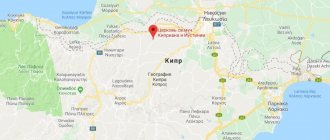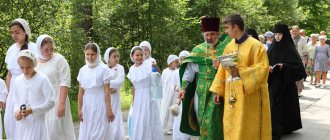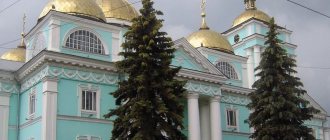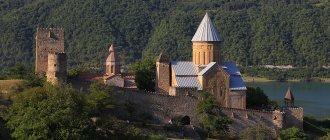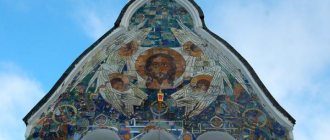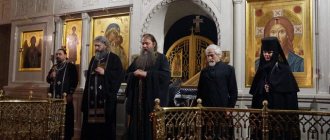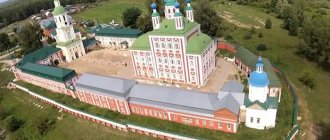Mir
Russia Kaluga region village of Old Shamordino Kazan Ambrosievskaya women's hermitage (Shamordinsky monastery) Map is loading…
{"format":"leaflet","minzoom":false,"maxzoom":false,"limit":50,"offset":0,"link":"all","sort":[""], "order":[],"headers":"show","mainlabel":"","intro":"","outro":"","searchlabel":"\u2026 \u0441\u043b\u0435\ u0434\u0443\u044e\u0449\u0438\u0435 \u0440\u0435\u0437\u0443\u043b\u044c\u0442\u0430\u0442\u044b","default":"","import-annotation":false,"width ":"auto","height":"350px","centre":{"text":"","title":"""link":"","lat":54.159999999999996589394868351519107818603515625,"lon": 35.8680599999999998317434801720082759857177734375,"icon":""},"title":"","label":"","icon":"","lines":[],"polygons":[],"circles":[ ],"rectangles":[],"copycoords":false,"static":false,"zoom":8,"defzoom":14,"layers":["OpenStreetMap"],"image layers":[] ,"overlays":[],"resizable":false,"fullscreen":true,"scrollwheelzoom":true,"cluster":false,"clustermaxzoom":9,"clusterzoomonclick":true,"clustermaxradius":80, "clusterspiderfy":true,"geojson":"","clicktarget":"","showtitle":true,"hidenamespace":false,"template":"","userparam":"","activeicon": "","pagelabel":false,"ajaxcoordproperty":"","ajaxquery":"","locations":[{"text":"\u003Cb\u003E\u003Ca href=\"/palomnik/%D0% 9A%D0%B0%D0%B7%D0%B0%D0%BD%D1%81%D0%BA%D0%B0%D1%8F_%D0%90%D0%BC%D0%B2%D1%80% D0%BE%D1%81%D0%B8%D0%B5%D0%B2%D1%81%D0%BA%D0%B0%D1%8F_%D0%B6%D0%B5%D0%BD%D1% 81%D0%BA%D0%B0%D1%8F_%D0%BF%D1%83%D1%81%D1%82%D1%8B%D0%BD%D1%8C_(%D0%A8%D0%B0 %D0%BC%D0%BE%D1%80%D0%B4%D0%B8%D0%BD%D1%81%D0%BA%D0%B8%D0%B9_%D0%BC%D0%BE%D0 %BD%D0%B0%D1%81%D1%82%D1%8B%D1%80%D1%8C)\» title=\»\u041a\u0430\u0437\u0430\u043d\u0441\u043a\u0430\ u044f \u0410\u043c\u0432\u0440\u043e\u0441\u0438\u0435\u0432\u0441\u043a\u0430\u044f \u0436\u0435\u043d\u0441\u043a\u0430\u0 44f\u043f\u0443\u0441\u0442\ u044b\u043d\u044c (\u0428\u0430\u043c\u043e\u0440\u0434\u0438\u043d\u0441\u043a\u0438\u0439 \u043c\u043e\u043d\u0430\u0441\u0 442\u044b\u0440\u044c)\ "" u043a\u0430\u044f\u0436\ u0435\u043d\u0441\u043a\u0430\u044f \u043f\u0443\u0441\u0442\u044b\u043d\u044c (\u0428\u0430\u043c\u043e\u0440\u0434\u0438\u0 43d\u0441\u043a\u0438\u0439 \u043c\u043e\u043d\u0430\u0441\u0442\u044b\u0440\u044c)\u003C/a\u003E\u003C/b\u003E\u003Chr /\u003E\u003Ca href=\"/palomnik/%D0%A1% D0%B2%D0%BE%D0%B9%D1%81%D1%82%D0%B2%D0%BE:%D0%90%D0%BD%D0%BD%D0%BE%D1%82%D0 %B0%D1%86%D0%B8%D1%8F\" title=\"\u0421\u0432\u043e\u0439\u0441\u0442\u0432\u043e:\u0410\u043d\u043d\u043e\u0442\u0430\ u0446\u0438\u044f\»\u003E\u0410\u043d\u043d\u043e\u0442\u0430\u0446\u0438\u044f\u003C/a\u003E: \u0441\u0442\u0430\u0432\u044 0\u043e\u043f\u0438 \u0433\u0438\u0430\u043b\u044c\u043d\u044b\u0439 \u0436\u0435\u043d\u0441\u043a\u0438\u0439 \u043c\u043e\u043d\u0430\u0441\ u0442\u044b\u0440\u044c\u0420 \u0443\u0441\u0441\u043a\u043e\u0439\u003Cspan class=\»smw-highlighter\» data-type=\»2\» data-state=\»persistent\» data-title=\»\u0418\ u043d\u0444\u043e\u0440\u043c\u0430\u0446\u0438\u044f\" title=\"\u0441\u0442\u0430\u0432\u0440\u043e\u043f\u0438\u0433\u0438\u043 0\u043b\u044c\ u043d\u044b\u0439 \u0436\u0435\u043d\u0441\u043a\u0438\u0439 \u043c\u043e\u043d\u0430\u0441\u0442\u044b\u0440\u044c \u0420\u 0443\u0441\u0441\u043a\u043e\ u0439 \u043f\u0440\u0430\u0432\u043e\u0441\u043b\u0430\u0432\u043d\u043e\u0439 \u0446\u0435\u0440\u043a\u0432\u0438, \u0440\ u0430\u0441\u043f\u043e\u043b \u043e\u0436\u0435\u043d\u043d\u044b\u0439 \u0440\u044f\u0434\u043e\u043c \u0441 \u0434\u0435\u0440\u0435\u0432\u043d\u0435 \u0439 \u0428\u0430\u043c\u043e \u0440\u0434\u0438\u043d\u043e \u041a\u0430\u043b\u0443\u0436\u0441\u043a\u043e\u0439 \u043e\u0431\u043b\u0430\u0441\u0442\ u0438, \u0432 12 \u043a\u043c \u043a \u0441\u0435\u0432\u0435\u0440\u0443 \u043e\u0442 \u041e\u043f\u0442\u0438\u043d\u043e\u0439 \u043f\u0443\u0441\u044 2\u044b\u043d\u0438. \u041e\u0431\u0438\u0442\u0435\u043b\u044c \u043e\u0441\u043d\u043e\u0432\u0430\u043d\u0430 \u0432 1884 \u0433\u043e\u0434\ u0443\u043f\u0440\u0435\u043f\ u043e\u0434\u043e\u0431\u043d\u044b\u043c \u0410\u043c\u0432\u0440\u043e\u0441\u0438\u0435\u043c \u041e\u043f\u0442\u0438\u0 43d\u0441\u043a\u0438\u043c\ u043f\u043e \u0437\u0430\u0432\u0435\u0449\u0430\u043d\u0438\u044e \u0435\u0433\u043e \u0434\u0443\u0445\u043e\u0432\u043d\u 043e\u0439\u0434\u043e\u0447\ u0435\u0440\u0438 \u043c\u043e\u043d\u0430\u0445\u0438\u043d\u0438 \u0410\u043c\u0432\u0440\u043e\u0441\u0438\u0438 (\u041a\u 043b\u044e\u0447\u0430\u0440 \u0435\u0432\u043e\u0439, 1818-1881) \u0438 \u043d\u0430 \u0435\u0435 \u0441\u0440\u0435\u0434\u0441\u0442\u0432\u0430.\"\u 003E\u003Cspan class=\" smwtext\"\u003E\u2026 \u003C/span\u003E\u003Cspan class=\"smwttcontent\"\u003E\u0441\u0442\u0430\u0432\u0440\u043e\u043f\u0438\u0433\u0438\u 0430\u043b\u044c \u043d\u044b\u0439 \u0436\u0435\u043d\u0441\u043a\u0438\u0439 \u043c\u043e\u043d\u0430\u0441\u0442\u044b\u0440\u044c \u0420 \u0443\u0441\u0441\u043a\u043e \u0439 \u043f\u0440\u0430\u0432\u043e\u0441\u043b\u0430\u0432\u043d\u043e\u0439 \u0446\u0435\u0440\u043a\u0432\u0438, \u044 0\u0430\u0441\u043f\u043e\ u043b\u043e\u0436\u0435\u043d\u043d\u044b\u0439 \u0440\u044f\u0434\u043e\u043c \u0441 \u0434\u0435\u0440\u0435\u0432\u043d\u 0435\u0439\u0428\u0430\u043c\ u043e\u0440\u0434\u0438\u043d\u043e \u041a\u0430\u043b\u0443\u0436\u0441\u043a\u043e\u0439 \u043e\u0431\u043b\u0430\u0441\u0 442\u0438,\u0432 12\u043a\ u043c \u043a \u0441\u0435\u0432\u0435\u0440\u0443 \u043e\u0442 \u041e\u043f\u0442\u0438\u043d\u043e\u0439 \u043f\u0443\u0441 \u0442\u044b\u043d\u0438. \u041e\u0431\u0438\u0442\u0435\u043b\u044c \u043e\u0441\u043d\u043e\u0432\u0430\u043d\u0430 \u0432 1884 \u0433\u043e\u0434\ u0443\u043f\u0440\u0435\u043f\ u043e\u0434\u043e\u0431\u043d\u044b\u043c \u0410\u043c\u0432\u0440\u043e\u0441\u0438\u0435\u043c \u041e\u043f\u0442\u0438\u0 43d\u0441\u043a\u0438\u043c\ u043f\u043e \u0437\u0430\u0432\u0435\u0449\u0430\u043d\u0438\u044e \u0435\u0433\u043e \u0434\u0443\u0445\u043e\u0432\u043d\u 043e\u0439\u0434\u043e\u0447\ u0435\u0440\u0438 \u043c\u043e\u043d\u0430\u0445\u0438\u043d\u0438 \u0410\u043c\u0432\u0440\u043e\u0441\u0438\u0438 (\u041a\u 043b\u044e\u0447\u0430\u0440 \u0435\u0432\u043e\u0439, 1818-1881) \u0438 \u043d\u0430 \u0435\u0435 \u0441\u0440\u0435\u0434\u0441\u0442\u0432\u0430.\u00 3C/span\u003E\u003C/span \u003E (\u041a\u043b\u044e\u0447\u0430\u0440\u0435\u0432\u043e\u0439, 1818-1881) \u0438 \u043d\u0430 \u0435\u0435 \u0441\u04 40\u0435\u0434\u0441\u0442 \u0432\u0430.","title":"\u041a\u0430\u0437\u0430\u043d\u0441\u043a\u0430\u044f \u0410\u043c\u0432\u0440\u043e\u0441\u0438\u0435\ u0432\u0441 \u043a\u0430\u044f \u0436\u0435\u043d\u0441\u043a\u0430\u044f \u043f\u0443\u0441\u0442\u044b\u043d\u044c (\u0428\u0430\u043c \u043e\u0440\u0434\u0438\ u043d\u0441\u043a\u0438\u0439 \u043c\u043e\u043d\u0430\u0441\u0442\u044b\u0440\u044c)","link":"","lat":54.1599999999999965893948683 51519107818603515625,"lon":35.8680599999999998317434801720082759857177734375," icon":""}],"imageLayers":[]}
54.160681; 35.870601
Russia, Kaluga region, Kozelsky district, village of Staroye Shamordino
village of Staroye Shamordino, Kaluga region
Russia
Help desk phone number:
, call from 10.30 to 16.30 (except Sundays).
Email:
Kazan Ambrosievskaya hermitage (unofficial name Shamordinsky monastery)
- a stauropegial convent of the Russian Orthodox Church, located near the village of Shamordino, Kaluga region, 12 km north of Optina Pustyn. The monastery was founded in 1884 by the Monk Ambrose of Optina according to the will of his spiritual daughter, nun Ambrosia (Klyucharyeva, 1818-1881) and at her expense.
History[edit]
The Kazan Ambrosievskaya stauropegial women's hermitage is located near the village of Shamordino, in one of the most beautiful corners of Holy Rus', between the ancient cities of Kaluga and Kozelsk. Founded in 1884 by the Monk Ambrose of Optina according to the will of his spiritual daughter, nun Ambrosia (Klyuchareva, 1818-1881) and at her expense. While still alive, looking out for elderly widows and orphans who wanted to devote themselves to serving God, she bequeathed the establishment of a women's community on the Shamordino estate that belonged to her.
The indispensable assistant of the Monk Ambrose in establishing the desert was his spiritual daughter, schema-nun Sophia (Bolotova, 1845-1888), who was completely devoted to the elder. On October 1, 1884, on the day the monastery opened, Mother Sophia was appointed its first abbess, and the monastery began to be called Kazan in honor of the Kazan Icon of the Mother of God revered there. The entire life of the Shamordino Hermitage took place under the guidance of the elders: the liturgical charter, monastic orders, construction work, assignment of obediences, etc. were arranged with the blessing of the Monk Ambrose. The number of nuns of the monastery was replenished mostly by sisters who were sent here by the priest himself. Arriving in Shamordino, he examined everything, marked out places for the construction of future temples, cells and other buildings and gave instructions. The Monk Ambrose and Mother Sophia paid a lot of attention to the spiritual life of the sisters, instilling in them such virtues as love for God and neighbors, and mercy. Despite the fact that Schema-nun Sophia ruled the monastery for only four years, she managed to do a lot during this time and earn the boundless love of the sisters. In 1987, the founder of the Shamordino monastery was glorified in the Cathedral of Tula Saints.
Mother Sophia's successors were schema-abbess Euphrosyne (Rozova, 1830-1904), Ekaterina (Sambikina, 1842-1911) and Valentina (Rozantseva, 1864-1919), also the spiritual children of Elder Ambrose and his disciples, Rev. Joseph and Anatoly (Zertsalova). By the beginning of the twentieth century, the monastery had become a major spiritual center; about 800 sisters of various ranks and origins labored here. Thanks to the generous patronage of the famous Moscow merchant Sergei Vasilyevich Perlov, all the buildings that have survived to this day were erected: the majestic Kazan Cathedral, the building of an almshouse with a house church in the name of the icon of the Mother of God “Quench My Sorrows,” a water pump. With his assistance, various workshops were created: painting, embossing, gold embroidery, bookbinding, carpet making, etc.
During the years of persecution of Orthodoxy, the Shamordian hermitage suffered the common fate of all Russian monasteries. In 1923, the monastery was closed and destroyed. The sisters were forced to settle in Kozelsk and nearby villages. Spiritually strengthened by the Optina elders, they humbly and with dignity passed all the trials that befell them. Many of them suffered martyrdom in prisons, camps and exiles. All lands and lands of the monastery became the property of the collective farm; a home for the disabled, a boarding school for street children, and a school were located in the former monastery buildings. But without God's blessing and skillful management, the huge economy soon fell into decay. Everything created by the sisters’ labor was ruined by the godless authorities.
Since March 1990, monastic life has resumed in the Shamorda desert. Abbess Nikona (Peretyagina, 1941-2012), nun of the Riga Monastery, was appointed abbess. The lamps lit up again and the service began. Monastic life gradually began to improve. That same year, on May 27, the church at the almshouse was consecrated in honor of the icon of the Mother of God “Quench My Sorrows.” This date was included in the chronicle of the monastery as the day of the revival of the monastery.
In 1996, on the site of the cell in which the Monk Ambrose reposed in the Lord in Shamordino, the first church in Russia in the name of the great elder was built and on July 28 it was consecrated by His Holiness Patriarch Alexy II. This temple is one of the main ones in the monastery; the entire liturgical cycle is performed in it every day.
The cell of Father Ambrose, which has survived to this day, is now located near the temple, not far from its historical location.
On August 13, 2005, after the completion of the main restoration work, the Kazan Cathedral, the main temple of the monastery, was consecrated. His Holiness Patriarch Alexy II and the bishops who arrived with him consecrated, in addition to the central one, two more side altars.
Currently, a full circle of worship is being performed in the monastery, the Inexhaustible Psalter is being read, akathists are being read before the revered icons of the Mother of God and St. Ambrose of Optina. Under the leadership of Mother Superior Nikona (Peretyagina), the monastery almshouse and hospital were reopened, and a Sunday school was organized for children from the surrounding villages. The monastery has its own subsidiary farm: a dairy farm, vegetable gardens, fields, an apiary, and is fully self-sufficient in agricultural products. Now there are more than one hundred and thirty sisters working in Shamordino, all of them are fully supported, receiving everything they need from the monastery.
On May 27, 2010, the monastery prayerfully celebrated the 20th anniversary of the revival of monastic life. On the eve of the desert, His Holiness Patriarch Kirill of Moscow and All Rus' visited for the first time and performed a solemn divine service in the Kazan Cathedral, which became an unforgettable holiday for the nuns of the monastery, its benefactors and guests. This date can be considered the beginning of a period of prosperity, when the most difficult restoration work was completed, the physical overload of the first years became a thing of the past and the main forces of the sisters were redirected to spiritual work as the main goal of the monastic rank.
A sad page in the history of this blessed time was the untimely and sudden death of dear and ever-memorable Mother Abbess Nikona, which followed on May 28, 2012. Only faith in the infinite mercy that her righteous soul should receive from the Lord helped the sisters endure this loss.
Currently, the monastery lives under the leadership of a new abbess - Abbess Sergius (Shcherbakova), who was elevated to the rank of abbot on July 6, 2014 in the Novodevichy Convent in Moscow. Mother Sergia, who was in the monastery for more than twenty years and helped the late Abbess Nikona in business, continued the established traditions and the established monastic way of life.
In 2015, on the occasion of the 25th anniversary of the revival of the monastery, His Holiness Patriarch Kirill again visited the Shamordino hermitage and awarded the Kazan Cathedral, which celebrated the 10th anniversary of its consecration, with the right to serve in it with the Royal Doors open until the Lord’s Prayer.
Under the gracious protection of the Mother of God, the Venerable Elder Ambrose, and Mother Sophia, the revived Shamordino monastery continues to live and offer humble prayers for our earthly Fatherland and Orthodox Christians around the world.
The heyday of the monastery
A number of saints labored in this monastery. After the death of the abbess, the nun Euphrosyne was appointed to the obedience of the abbess, who was canonized as a saint in 1987.
Previously, there was an almshouse, a hospital, a shelter for orphan girls, and several monasteries
In 1901, the monastic community received the status of a monastery and was renamed St. Ambrose Hermitage. In the same year, the sister of the famous writer Leo Tolstoy took monastic vows here.
The constructed temples, as well as buildings, are recognized as architectural monuments. Before the revolution, the question of granting stauropegial status to the monastery was raised, but the revolution prevented this.
In 1918 the number of nuns exceeded 1,000. The final closure took place in 1923.
Temples[edit]
- Kazan Cathedral
- the main temple of the monastery
The main temple of the monastery in honor of the Kazan Icon of the Mother of God was built with the blessing of St. Elder Ambrose. The design of the temple was made in the workshop of the architect S.V. Sherwood.
- Temple in honor of St. Ambrose of Optina
In the last century, on this site there was a house-cell, in which the Elder lived when he came to the monastery. Old and young, rich and poor came here. In this house, Father Ambrose reposed in the Lord on October 10/23, 1891. After death, through the efforts of his spiritual child S.V. Perlov, a brick case was built over this house.
- Temple in honor of the Holy Trinity
Church in the name of the Most Holy Trinity with a border in honor of the icon of the Mother of God “Life-Giving Spring”. This is the first church of the monastery, originally consecrated on the day of its opening, October 1/14, 1884, in honor of the Kazan Icon of the Mother of God. Here, before Her miraculous image, the humble elder Ambrose offered his prayers.
- Temple in honor of the icon of the Mother of God “Quench my sorrows”
In the northern part of the monastery, through the efforts and funds of Anna Yakovlevna Perlova, a two-story brick almshouse was built at the end of the 19th century. There is a temple in honor of the icon of the Mother of God “Quiet My Sorrows,” which was consecrated on October 25/November 7, 1902 by Kaluga Archbishop Veniamin.
- Kazan Cathedral
- Temple in honor of St. Ambrose of Optina
- Temple in honor of the Icon of the Mother of God “Quench My Sorrows”
- Temple in honor of the Holy Trinity
Temples and services
Currently active churches:
- Assumption, which has two chapels, the Nativity of the Virgin Mary and St. Nicholas; the building damaged by chemical fertilizers is still being decontaminated: for example, in the central part of the building the concentration of ammonium nitrate greatly exceeds the norm, so restoration is not even possible here yet;
- St. First Martyr Thekla; this new temple was consecrated in 2021, and regular services are held here.
Services are performed according to the monastic rules. As has been the custom since the first days of the community’s existence, every day there is a procession of the cross, during which an akathist to the Assumption is read.
Patronal holidays[edit]
Icon of the Blessed Virgin Mary “Kazan”
— July 21, November 4
Icon of the Most Holy Theotokos “Quench My Sorrows”
— February 7
Day of the Holy Trinity
— 50th day after Easter
Ambrose of Optina, Rev.
— July 10, October 23
Content
- 1 Pafnutiev-Borovsky Monastery
- 2 Kazan Convent (Kaluga)
- 3 Krestovsky Monastery
- 4 Assumption Likhvinsky Gremyachev Convent
- 5 Meshchovsky St. George Monastery
- 6 Savior Not Made by Hands of the Deserts
- 7 Optina Pustyn
- 8 Kaluga Tikhonova Hermitage
- 9 Nikolo-Chernoostrovsky Monastery
- 10 Lavrentiev Monastery
- 11 Spaso-Preobrazhensky Vorotyn Convent
- 12 Kazan Ambrosievskaya women's hermitage (Shamordinsky monastery)
- 13 Sharovkin Assumption Convent
- 14 Holy Dormition Ferapontov Monastery
- 15 Uspenskaya Feklina women's hermitage
- 16 Theotokos-Nativity maiden hermitage
- 17 Bishop's Metochion of the Holy Myrrh-Bearing Women (Klykovo)
How to get there[edit]
Address
: 249706, Kaluga region, Kozelsky district, p/o Kamenka, Shamordino, monastery
Help desk phone number:
, call from 10.30 to 16.30 (except Sundays).
Email:
Official site:
https://www.shamordino-m.ru/
Directions:
- By car:
Kozelsk is located 280 km south of Moscow. Take the Kyiv highway towards Kaluga. You pass the turn to Kaluga. According to the signs, there are two such turns: the first (to the right) leads to the bridge, and the second (to the left) is the main one. After passing the turn to Kaluga, watch out for the road bridges that pass over the road; you need the second one, it is located at the 186th kilometer of the highway. You need to cross this bridge, after it there will immediately be a sign to Optina Pustyn. At the end of the bridge there will be a sign - Kozelsk. Then all the time straight ahead, until the monument to the city of Przemysl, there follow the sign, turn right. The road from the highway to Kozelsk is for the most part not bad, but you can also drive through Kaluga, especially on the way back; signs for Moscow lead through Kaluga.
You can travel both along the Kievskoye and Kaluzhskoye highways. They intersect in the Obninsk area for about 100 km, then another 140 km along the Kyiv highway.
- On your own:
On your own: from the Teply Stan metro station by regular bus to Kozelsk, Sosensky or Khvastovichi
Bus station metro station Teply Stan: 427-9077 (inquiries), 101-3536 (inquiries, reservations)
How to get there: exit the first carriage when moving from the Center, in the underground passage to the right to the end, then left and 200 m along Novoyasenevsky Prospekt.
You can find the bus schedule from Moscow on the website of the Teply Stan metro station.
You can find the bus schedule from Kaluga on the bus station website.
You can find the bus schedule to Moscow on the Kozelsk website.
Before your trip, we recommend calling the bus station to clarify the bus schedule, as seasonal schedule changes are possible, as well as transfers and cancellations of flights for technical reasons. Kozelsk bus station: (code 48442)22502 Kozelskoye ATP: (code 48442)22240
- By train:
You can also take a train from Kievsky station to Kaluga, then by regular bus to Kozelsk, Sosensky, Ulyanovo or Khvastovichi.
You can find the bus schedule from Kaluga on the bus station website.
Before reaching Kozelsk, stop in the village. Kamenka near the sign for Shamordino and then 1 km to the right to the monastery.
Where is
The monastery is located in the Kaluga region near the village of Shamordino (you can also find the name Shevardino in historical documents).
Bird's eye view
The distance to Kozelsk is only 14 kilometers, and to the famous Optina Pustyn 20 kilometers. From the side of highway number P92, the domes of the complex are already visible, so it’s quite difficult to get lost.
Please note: there are special flights directly to the main gate, but you can get there on your own.
Pilgrim[edit]
The territory of the Kazan Ambrosievskaya stauropegial women's desert in Shamordin is open to the public from 8.00 to 20.00.
Where to stay[edit]
Pilgrims are accepted for overnight accommodation by prior appointment using the “Application to visit the monastery”
. Your application must be sent no later than a week before the group arrives.
The monastery does not accommodate men or women with small children overnight (there are no necessary conditions for them).
Groups are accommodated overnight in the monastery only from May 1 to November 30: on weekdays until 20.00 (until the monastery closes); on Saturdays and on the eve of holidays until 14.00.
Pilgrims are accommodated in houses for 40 people with bunk beds. Bed linen is provided, but if you wish, you can bring your own.
The leader is obliged to prepare pilgrims for visiting the monastery and familiarize them in advance with the general rules of behavior on the territory of the monastery.
He is responsible for the entire group during the entire stay in the monastery.
The sisters of the monastery will be grateful to pilgrim groups who want to help the sisters and work for the glory of God in the monastery. Possible obediences in the monastery:
- cleaning of churches and premises, the territory of the monastery;
- work in the garden (planting, weeding, watering, harvesting);
- in the refectory and kitchen.
You can find out detailed information about the rules of behavior, daily routine, excursions on the monastery website
.
Schedule of services[edit]
During weekdays:
03:00 - prayer service to St. Ambrose of Optina, morning prayers, midnight office, matins, 1st hour
06:00 - akathist of the day, 3rd and 6th hour, Divine Liturgy
18:00 - 9th hour, Vespers, Compline with the rule
On Saturday (in the Kazan Cathedral):
03:00 - prayer service to St. Ambrose of Optina, morning prayers, midnight office, matins, 1st hour
06:00 - akathist of the day, 3rd and 6th hour, Divine Liturgy
15:00 - 9th hour, Small Vespers, Compline with the rule
18:00 — all-night vigil, 1st hour
On Sunday:
03:00 - morning prayers, Sunday midnight office (with reading of the akathist to the Most Holy Trinity), 3rd and 6th hours, Divine Liturgy (in the Church of St. Ambrose)
07:00 - morning prayers, 3rd and 6th hours, Divine Liturgy (in the Kazan Cathedral)
18:00 - 9th hour, Vespers, Compline with the Rule (in the Church of St. Ambrose)
Rules of conduct in the monastery
Arriving at the monastery, you should follow the rules of conduct. They are typical for an Orthodox church. In addition, clothing should not be provocative. Men are advised to wear trousers and a long sleeve shirt or suit. Women should wear a long skirt, long sleeves and a headscarf. The head must be covered.
Visitors are prohibited from drinking alcohol, smoking or listening to popular music. You cannot enter residential buildings, distract nuns with conversations or take photographs of them.
Uspenskaya Feklina women's hermitage[edit]
Date of foundation
: 2016
Status
: active
Address:
249731, Kaluga region, Kozelsky district, Senino-Pervoe village, st. Central
Official site:
https://www.fekla-mon.ru/
The Assumption Feklina women's hermitage is the first convent in the Kozel diocese. It was created in a place where monastic life had never existed before. There is a hotel for pilgrims at the monastery.
On July 15, 2021, at a meeting of the Holy Synod of the Russian Orthodox Church, chaired by His Holiness Patriarch Kirill of Moscow and All Rus', the report of the Chairman of the Synodal Department for Monasteries and Monasticism, Archbishop Feognost of Sergiev Posad, was considered regarding the received petitions for the opening of monasteries and for the appointment of abbots and abbesses of monasteries .
In connection with the request of Bishop Nikita of Kozelsky and Lyudinovo, the Holy Synod decided to open the Assumption Feklina Women's Hermitage Monastery in the village. Senino, Kozelsky district, Kaluga region, and appoint nun Vitaly (Kochetova) as abbess of this monastery.
Spaso-Preobrazhensky Vorotyn Convent[edit]
Date of foundation
: not earlier than 1498
Status
: active
Address
: Kaluga, Spas village
Official site:
https://spasnaugre.ru/index.php
Founded shortly after the “Standing on the Ugra” with funds from the prince. D. F. Vorotynsky. It was abandoned in 1725 and abolished in 1764. In 1763, the cathedral, the Church of the Entry with a refectory and one cell were made of stone. To the beginning XIX century cells and walls have been lost. To the beginning XX century There were 2 churches left that were parish. In the 1930s, the ancient cemetery was destroyed. Resumed in mid. 2000s as female. It is the courtyard of the Kazan Monastery in Kaluga.
Nikolo-Chernoostrovsky Monastery[edit]
Date of foundation
: con. XVI century
Status
: active
Address
: Kaluga region, Maloyaroslavets, st. Kutuzova, 2
St. Nicholas Chernoostrovsky Monastery is an Orthodox monastery in the city of Maloyaroslavets, Kaluga region. The monastery is located on the high bank of the Luzha River (a tributary of the Protva), on the top of the so-called Special Mountain, otherwise called the Black Ostrog. Hence the name of the monastery (Chernoostrogsky eventually transformed into Chernoostrovsky). During the Time of Troubles, the monastery was destroyed by the Lithuanians and restored only in 1659. In 1775, the monastery was abolished due to poverty.
Meshchovsky St. George Monastery[edit]
Date of foundation
: 2nd quarter XVII century
Status
: valid
Address
: Kaluga region, Meshchovsky district, pos. Iskra, st. Monastyrskaya, 3
Telephone
: (48446) 9-23-83
A monastery founded near Meshchovsk after the Time of Troubles with the help of Queen Evdokia Lukyanovna and named in memory of the monastery that existed before the Time of Troubles on the Ressa River. In 1764 he was transferred to supernumerary status, in the 19th century. sufficiently well-off, brick cells and a fence with towers were built. In 1918 it was transformed into a commune, finally closed in 1929, the buildings are occupied by the Iskra commune. By the 1990s, the buildings were abandoned. Reopened in 2001, it is currently being actively restored.
Assumption Likhvinsky Gremyachev Convent[edit]
Date of foundation
: XV century
Status
: active
Address
: Kaluga region, Peremyshl district, village. Gremyachevo
Official site:
https://gremyachevo.orthodoxy.ru/
Known since the 15th century. like a man's. To the beginning XVIII century Two churches, a refectory, and a fence were built in brick. Abolished in 1764, the churches were converted into parish churches. All R. XX century buildings were significantly damaged, the fence was lost. In 2008 it was renewed as a women's one. Assigned to the Maloyaroslavets Nikolo-Chernoostrovsky Monastery.
Lavrentiev Monastery[edit]
Date of foundation
: no later than 1564
Status
: active
Address
: Kaluga, st. Shirokaya, 49
Telephone
: (4842) 55-59-36
Official site:
https://www.splavrenty.ru/
Founded on the site of the Church of the Nativity of Christ, in which St. prayed. Lavrenty. The exact time of its founding is not known. Ruined in 1617, restored after 1622. In 1776-1800, the monastery housed the Theological Seminary, then the Bishop's House. By the beginning of the twentieth century. in the monastery there were 3 churches, a bell tower, the building of the former bishop's house, cells, a fence with towers (all stone structures), as well as a necropolis. Closed in 1918, used as a prison camp, then as a school and housing. Only the building of the former bishop's house has survived. Reopened in 1994 as the Bishop's Compound.
Kaluga Tikhonova Hermitage[edit]
Date of foundation
: 2nd half. XV century
Status
: valid
Address
: Kaluga region, Dzerzhinsky district, village. Lev Tolstoy
Telephone
: (48434) 3-38-87
Founded according to legend in the 2nd half. XV century St. Tikhon of Kaluga. During the Troubles it was ruined in the 1st half. XVII century restored The first stone church - the Transfiguration Cathedral - began to be built in 1677. By the beginning of the twentieth century. in the monastery there were 4 churches, a five-tier gate bell tower built in 1894, 5 fraternal buildings, a rector's and hospital buildings, a refectory, a prosphora, a bakery, a candle factory, utility buildings, a horse yard, a house for monastic workers and a fence with towers. Closed by decree of 1918, finally liquidated in 1924, the territory was occupied by an agricultural technical school, then a military unit, the buildings were damaged and partially destroyed. Revived in 1993, the surviving buildings were gradually transferred to the monastery, 3 churches were restored, the cathedral was built again.
Pafnutev-Borovsky Monastery[edit]
Date of foundation
: 1444
Status
: active
Address
: Kaluga region, Borovsky district, Borovsk, st. Dmitrova, 1
Telephone
: (48438) 4-37-39; (48438) 6-61-96
Official site:
: https://www.pafnuty-abbey.ru/
Founded in 1444 Ave. Paphnutius Borovsky - a prominent church figure, spiritual mentor of St. Joseph Volotsky, Metropolitan. Makaria and others. In the XVI-XVII centuries. one of the largest and richest monasteries in central Russia, visited by the Grand Dukes of Moscow and Tsars. In 1610, after a siege, it was stormed and destroyed by the Poles, later restored. Most of the brick cell buildings and walls with towers were built in the 17th century; there are also more ancient structures. In 1812 it was destroyed by the French, during reconstruction in the 19th century. Some of the old buildings were dismantled. Closed in 1923, the territory housed a vocational school (later a mechanization school, and an agricultural technical school in 1962-1992) and a museum (closed in the 1930s). Restoration work began in 1955, and since 1968 a museum has operated on part of the monastery territory. Returned to believers in 1990, completely transferred to the diocese in 1992.
Sharovkin Assumption Convent[edit]
Address:
Russia, 249136, Kaluga region, Peremyshl district, village. Ilyinskoe
Tel.:
8-910-868-81-23;
Official site:
https://sharovkin-monastir.ru/
Sharovkin Assumption Monastery is a functioning monastery of the Russian Orthodox Church, located in the village of Ilyinskoye, Kaluga region, in the Kaluga diocese on the right bank of the Zhizdra River, 40 km from the city of Kaluga. It is under state protection (protection category is federal). There is a hotel at the monastery.
The undeservedly forgotten Assumption Sharovkin Monastery, located on the edge of a cliff near the Zhizdra River, on the edge of the village of Ilyinskoye near Przemysl, can rightfully be called the pearl of Kaluga land. The Sharovkin Monastery - once a men's monastery - was popularly nicknamed after the surname or nickname of its founder, the monk Sharovka named Theognost. He fell asleep in the Lord in 1545 and was buried near the southern altar wall of the cathedral church. It is symbolic that “sharovka” is the name of a local river mollusk, in whose mother-of-pearl shell a snow-white pearl is born from a simple dark grain of sand.
Holy Dormition Ferapontov Monastery[edit]
Address:
Kaluga region, Mosalsky district, Borovensk village
Contact page:
https://vk.com/ferapontov_mon
The Holy Dormition Borovensky Monastery was founded at the end of the 14th century by the disciple of St. Sergius of Radonezh - Rev. Ferapont of Borovensky. This is where another name for the monastery comes from - Ferapontova Hermitage.
Today, the monastery is creating conditions for the brethren to live, who are ready to move into the revived monastery. A book was ordered for writer Nadezhda Smirnova about the Ferapont Monastery. A booklet was published to coincide with the anniversary celebrations in honor of the 700th anniversary of St. Sergius of Radonezh, teacher and mentor of St. Ferapont of Boroven.
Holy Dormition Ferapont Monastery The icon of St. Ferapont of Boroven is currently being painted. Due to the continuity of monastic tradition, the holy image was commissioned from the icon painter of the Trinity-Sergius Lavra. Upon completion of the work, a ceremonial transfer of the icon to the Borovensky Monastery is expected.
Optina Pustyn[edit]
File:Optina Pustyn.jpg
Date of foundation
: con. XIV - beginning XV centuries
Status
: active
Address
: Kaluga region, Kozelsky district, Kozelsk, Optina Pustyn monastery
Telephone
: (48442) 5-01-15
Official site:
: https://www.optina.ru/
Founded in con. XIV - beginning XV centuries According to legend, the founder was the repentant robber Opta, and a monk - Macarius. Initially it was common - male and female, then - male. In 1724 he was assigned to the Belevsky Transfiguration Monastery, but in 1726 he regained independence. Starting from the 2nd quarter. XIX century and until its closure, the largest eldership center in Russia was visited by numerous pilgrims and many outstanding cultural and artistic figures. Closed in 1918, the vast majority of the brethren were repressed. By 1924 all churches were closed. The territory and buildings were used at various times for a local history museum, an orphanage, a sanatorium, a sawmill, an NKVD camp, an infirmary, military units, vocational schools, and housing. After the museum was liquidated in 1928, gradual destruction and looting of the monastery began. The four-tiered stone bell tower of 1802-1804, flanked by fraternal cells, was destroyed down to the lower tier, but has now been restored without strict adherence to the previous forms. Fence gray XIX century with seven towers was partially destroyed, but has now been restored. In 1974, the territory was taken under state protection, and slow restoration of the buildings began. The monastery was transferred to the Russian Orthodox Church in 1987, and restored in 1988. To date, it has been restored and is actively visited by pilgrims.
Currently it has the status of stauropegial. Near the monastery are the holy springs of Ambrose of Milan, Paphnutius of Borovsky and Seraphim of Sarov.
Krestovsky Monastery[edit]
Date of foundation
: 1870s
Status
: active
Address
: Kaluga, st. Freedom Field, 65, 65A
Formed in the 1870s at the Church of the Exaltation of the Cross and adjacent buildings: a stone two-story building built in 1854 with cells and a refectory and a wooden almshouse for clergy. XIX century Stone fence gray XIX century with Gothic turrets and Holy Gates. Abolished in 1918. On the territory of the monastery there are buildings of the 2nd and 17th schools and adjacent buildings, including the monastery building of 1854 and a prosphora. Restored on November 9, 2006 as the Bishop's Compound. The two surviving buildings were returned to the monastery.
